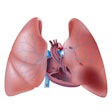The U.S. Centers for Medicare and Medicaid Services (CMS) has proposed a significant reimbursement reduction to technical component codes for diagnostic and screening mammography computer-aided detection (CAD) that would take effect in 2007. Under the proposal, the $15.92 reimbursement rate for current procedural terminology (CPT) codes 76082 and 76083 would drop to $14.02 in 2007.
By 2010, reimbursement would drop to $7.20, a 54.77% decrease, according to an analysis of the proposal, reported by AuntMinnie.com. The proposal does not differentiate between the use of CAD with full-field digital mammography (FFDM) or film-screen mammography (FSM), which requires the images to be digitized before processing and creates a more labor-intensive, time-consuming process, according to a release from the American College of Radiology (ACR).
Theresa Wade, administrator/business manager at the Elizabeth Wende Breast Clinic in Rochester, NY, agrees with the ACR's assessment.
It's more work to run a film image through CAD than a digital one, she said, because digital images go directly to the viewer for the physician to read -- an automatic process that doesn't require additional work from staff.
"For the film-screen we have an employee who runs the film through a digitizer," Wade said. "In our facility, this is a full-time job. The films have to be carried to the digitizer, someone has to run them through it, and then the chart and films are hung up for the doctor to read along with the CAD image."
CAD has become a standard of care in mammography in recent years, but these cuts could have a chilling effect on the technology's adoption, according to some experts. Although Wade noted that the reimbursement change isn't likely to cause those facilities that already use CAD technology to stop.
"We utilize CAD on all of our screening and diagnostic mammograms, and we wouldn't stop just because the reimbursement was reduced," said Dr. Stamatia Destounis, a radiologist at the Elizabeth Wende Breast Clinic.
The clinic is a high-volume facility that read more than 80,000 mammograms in the past year. CAD is used with a double-physician read.
"It is just one more tool for our docs to use to pick up a cancer," Destounis said. "We investigated CAD years ago and performed a prospective clinical screening trial between 2000 and 2002 that revealed a (7%) increase in (the) breast cancer detection rate by adding CAD to our typical two-radiologist read," she said.
However, the proposed cuts will put a crunch on the bottom line, which is already being strained by the technology, Wade said.
"In our facility, the actual cost to do a CAD using our relative value units and office expenses is $19.71," Wade noted. "Medicare reimbursement in this area right now is $18.19. So we are losing money on CAD right now."
But this is not the case across the board.
"Private payors, on the other hand, pay as much as $21.74 for CAD," she added.
CMS officials reported they based the suggested revisions on the relative amount of physician work required to perform mammography CAD.
But some people say the revisions are going too far. The reductions become problematic when CAD cannot pay for itself and, according to insurance companies such as Aetna and Cigna, when its use is considered part of a screening program, stated Bonnie Rush, president of San Diego-based Breast Imaging Specialists.
The ACR also lists CAD in the standard guidelines for using a screening mammogram as an additional tool, similar to a second read. This does not designate it a standard of care, because second reads are not themselves considered a standard of care, but it certainly places more weight on CAD's use, Rush said.
The final amount of the reduction and its timing will determine how deeply the cuts will be felt. Depending on the type of facility, the effect could be substantial or minimal, Rush noted.
Those facilities that are considering purchasing CAD will move more slowly or scrap plans altogether if there is no revenue incentive to add the technology because of the cuts. It will likely be less of an issue for those facilities that already use CAD, because they will probably have paid off the initial investment and will only need to meet associated costs, Rush said.
Many lower-volume facilities are not using CAD right now because it does not pay for itself quickly enough. A reduction will only ensure that they will not purchase the technology in the future.
These cuts may set up situations in which facilities give information to women about where to send their films to be processed in a CAD unit -- but the women will have to pay for the read, then get a comparison read done as well. This is how the technology was used before it was implemented in imaging facilities, Rush said.
However, the number of studies showing the value of CAD is growing, and as more studies validate its value, it may indeed prove itself to be a standard of care issue for facilities to consider when they provide screening mammography.
"Ultimately, the value of CAD will progress as it becomes a more sophisticated tool, and this may force facilities to add CAD and lose money in screening mammography services as a result," Rush said. "(This is) a sad state of affairs. If this should occur, then the reduction in reimbursement will not excuse facilities from offering this tool when it is seen as a means of increasing the chances of early detection."
Rush thinks that it is important for facilities to do the following:
- Remain updated about the value of CAD in recognized publications.
- Be aware of statements on care standards adopted in principal by insurance companies.
- Avail themselves of information or opinions provided by nationally recognized organizations (such as the ACR).
- Know whether other local mammography providers offer CAD.
Staying on top of these issues will help mammography facilities to keep current on this issue and prevent them from becoming embroiled in lawsuits for delayed diagnoses if they do not implement CAD. Overall, reductions such as this one, coupled with the inability of facilities to afford new technology, may contribute to the changing landscape of mammography.
"As with the utilization of full-field digital mammography and the need to justify the acquisition of any new technology, we may see facilities decide not to continue providing mammography as it becomes even more of a financial loss, and that will be a sad result, particularly for women (in smaller communities)," Rush said.
By Kelly Bilodeau
AuntMinnie.com contributing writer
December 8, 2006
The "Mammography Regulation and Reimbursement Report" is a 12-page monthly newsletter designed specifically for mammographic technologists and supervisors that is published by HC Pro. The periodical offers ideas for better practice management from peers, billing tips, MQSA regulatory updates and guidance, and business ideas related to breast imaging. For a free trial subscription, please click here.
Related Reading
How old is too old for a mammogram? October 6, 2006
New workflow, personnel needed for adopting digital mammography, August 10, 2006
Take care when coding for digital mammography and CAD, July 13, 2006
Easing the pressure of compression for patients, June 27, 2006
Digital mammography: Can your facility afford to make the leap? May 11, 2006
Copyright © 2006 HC Pro



















